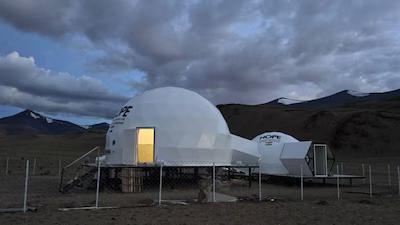
ISRO Sets Up Station in Ladakh to Simulate Life on Moon & Mars
The Indian Space Research Organisation (ISRO) has made a significant breakthrough in its quest to explore the vast expanse of space. Recently, ISRO set up the Himalayan Outpost for Planetary Exploration (HOPE) in Ladakh’s Tso Kar Valley, a region known for its extreme climate conditions similar to those found on Mars. The station will simulate life on the moon and Mars, testing various life-support systems for future lunar and Martian missions.
The HOPE station is a crucial step towards preparing ISRO’s astronauts for the challenges they may face during future space missions. For ten days, starting from August 1, two crew members will undertake various tests at the facility to assess the feasibility of sustaining life in such harsh environments.
Why Tso Kar Valley?
Tso Kar Valley was chosen specifically for its unique conditions that closely resemble those on Mars. The region receives high levels of ultraviolet (UV) radiation, has low atmospheric pressure, and is characterized by extreme cold temperatures. Additionally, the valley’s saline permafrost is similar to the Martian surface. These conditions will allow ISRO to test the life-support systems and equipment designed for lunar and Martian missions in a simulated environment.
The HOPE station is designed to simulate the conditions on both the moon and Mars. The facility is equipped with specialized equipment and instruments to mimic the harsh conditions found on these celestial bodies. The crew members will conduct various tests, including experiments on food production, wastewater management, and air recycling. These tests will help ISRO refine its life-support systems and ensure the well-being of astronauts during extended space missions.
What to Expect
During the ten-day simulation mission, the two crew members will be isolated from the outside world, with limited communication with the outside world. They will be tasked with monitoring and maintaining the life-support systems, as well as conducting experiments and tests. The crew will also have to manage their daily routine, including sleeping, eating, and exercising, in the simulated Martian environment.
The HOPE station is equipped with a range of specialized equipment, including life-support systems, air recycling units, and specialized food production systems. The facility also has a unique soil mixture that mimics the Martian surface, which will allow the crew to conduct experiments on plant growth and agriculture in a Martian environment.
Significance of the HOPE Station
The HOPE station is a significant milestone in ISRO’s journey to explore the moon and Mars. The facility will provide valuable insights into the feasibility of sustaining life on these celestial bodies and will help refine the life-support systems designed for future missions.
The success of the HOPE station will pave the way for ISRO’s future missions to the moon and Mars. The organization is planning to send its first manned mission to space in the near future, and the HOPE station will play a crucial role in preparing its astronauts for the challenges they may face during such missions.
Conclusion
ISRO’s HOPE station in Ladakh’s Tso Kar Valley is a significant step towards exploring the vast expanse of space. The facility will simulate life on the moon and Mars, testing various life-support systems for future lunar and Martian missions. The success of the station will provide valuable insights into the feasibility of sustaining life on these celestial bodies and will pave the way for ISRO’s future missions to the moon and Mars.






